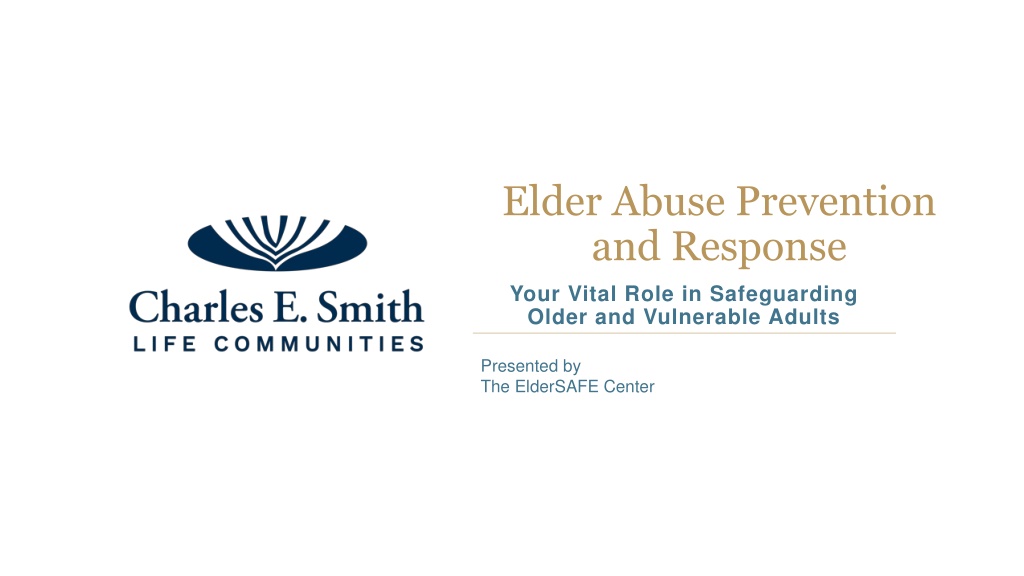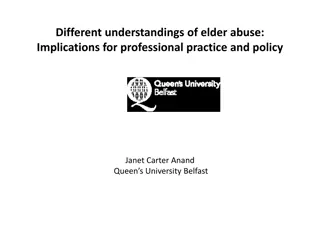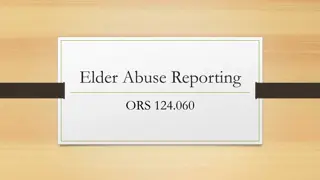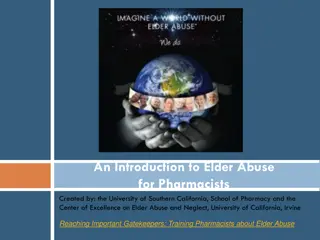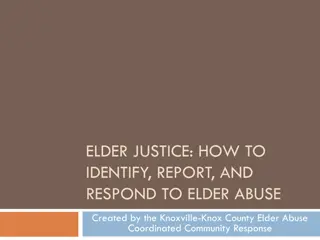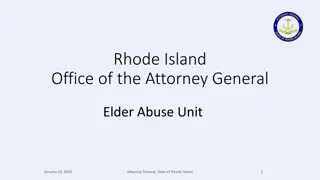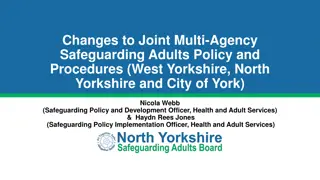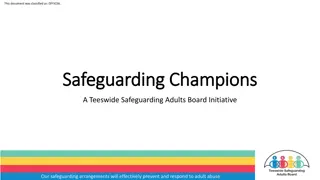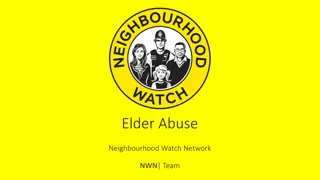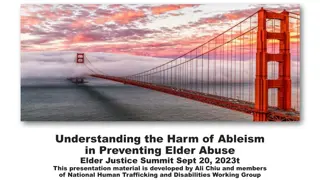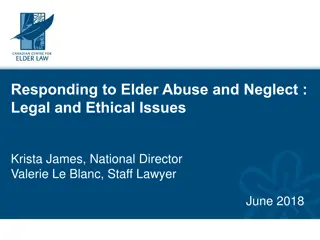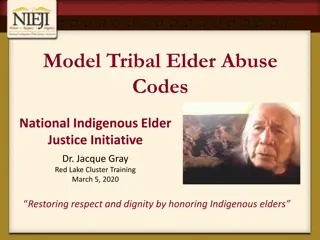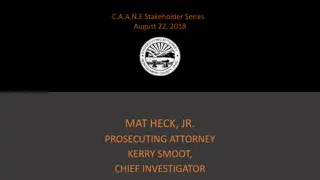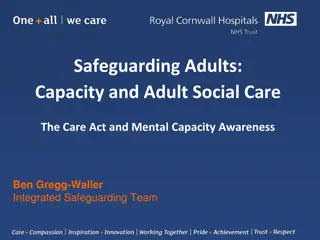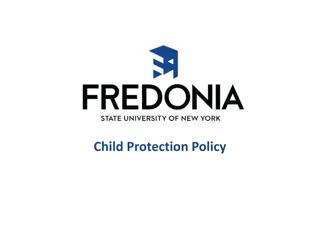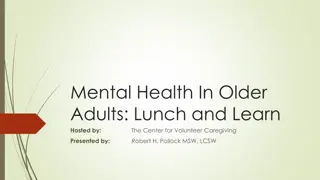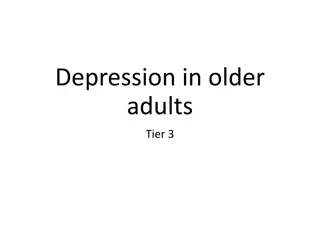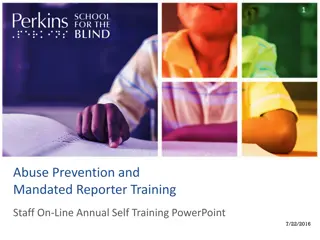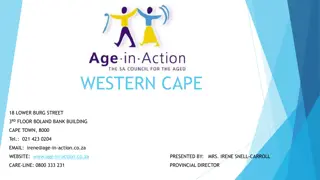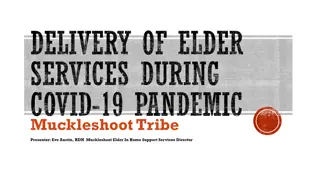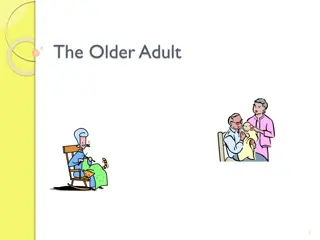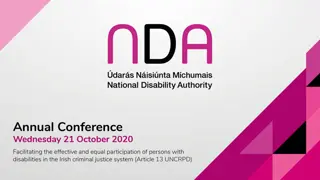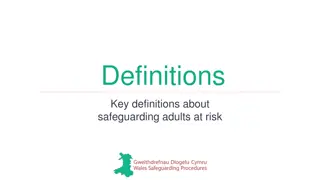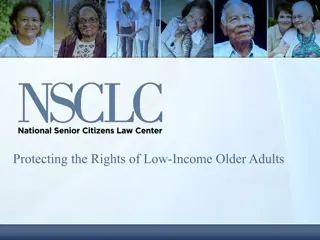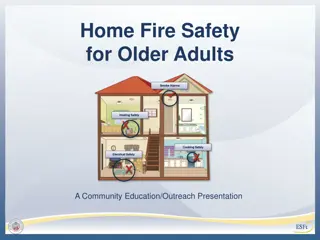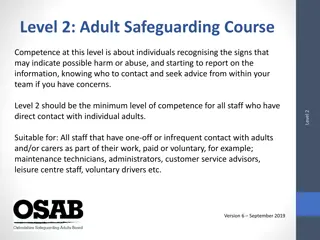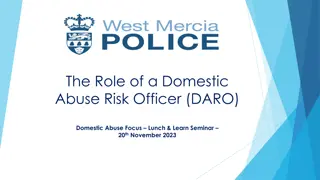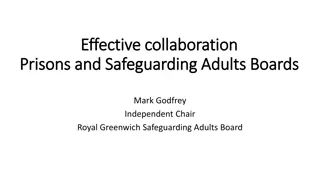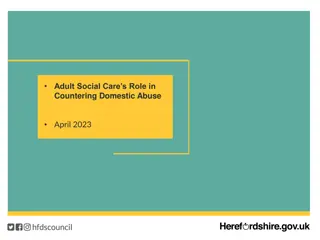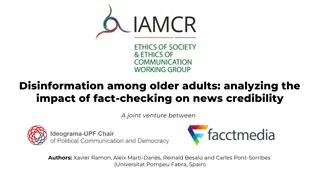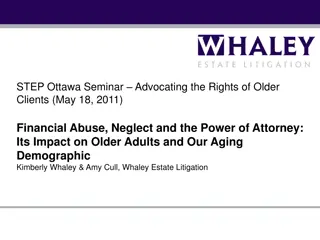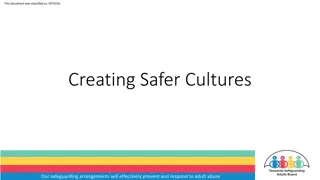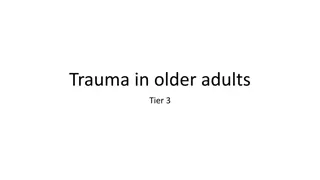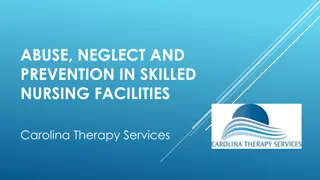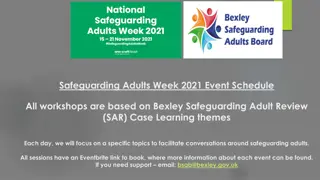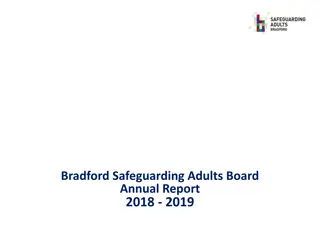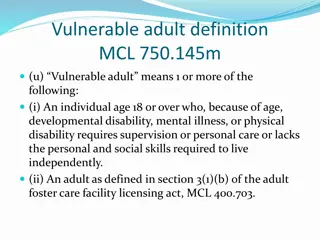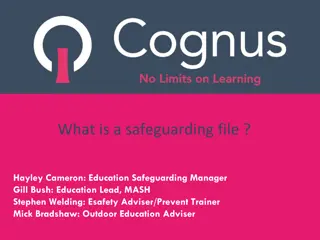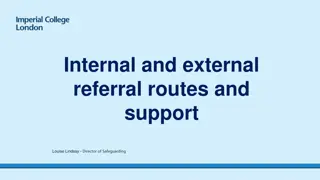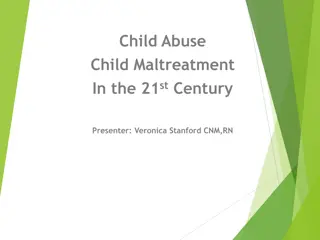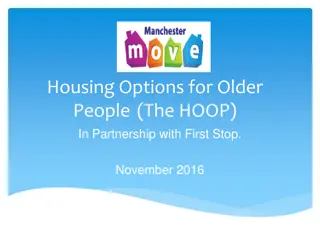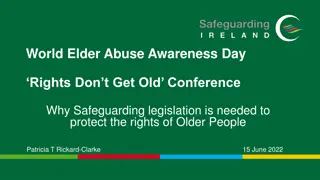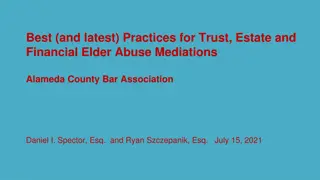Understanding and Preventing Elder Abuse: Your Role in Safeguarding Older Adults
This presentation by The ElderSAFE Center sheds light on the crucial topic of elder abuse prevention and response. It covers the foundation of trauma, understanding different types of elder abuse, recognizing warning signs, reporting procedures, and introduces ElderSAFE as a valuable resource. Trauma experiences, re-emergence of trauma in later life, and signs of emotional distress are also discussed, emphasizing the importance of safeguarding and supporting vulnerable older adults.
Uploaded on Sep 27, 2024 | 0 Views
Download Presentation

Please find below an Image/Link to download the presentation.
The content on the website is provided AS IS for your information and personal use only. It may not be sold, licensed, or shared on other websites without obtaining consent from the author. Download presentation by click this link. If you encounter any issues during the download, it is possible that the publisher has removed the file from their server.
E N D
Presentation Transcript
Elder Abuse Prevention and Response Your Vital Role in Safeguarding Older and Vulnerable Adults Presented by The ElderSAFE Center
Presenters Tovah Kasdin, ElderSAFE Center Director Charles E. Smith Life Communities KerryAnn Aleibar, ElderSAFE Center Program Manager Charles E. Smith Life Communities Sydney Palinkas, ElderSAFE Center Community Educator Charles E. Smith Life Communities 2 | CHARLES E. SMITH LIFE COMMUNITIES
Objectives Lay the foundation with a discussion of trauma Gain an understanding of elder abuse and its types Discuss warning signs of abuse Discuss reporting and Adult Protective Services Learn about ElderSAFE and how it can be a resource 3 | CHARLES E. SMITH LIFE COMMUNITIES
Trauma Trauma is the unique individual experience of an event or enduring conditions, in which: An individual s ability to integrate his/her emotional experience is overwhelmed; An individual experiences a threat to their life or a loved one s; There are long-lasting adverse effects to the individual s functioning and their well-being (SAMHSA, 2014) 4 | CHARLES E. SMITH LIFE COMMUNITIES
Trauma Experiences War / combat Death of a loved one Natural disaster Divorce Bullying Sexual or physical assault Miscarriages Domestic violence 5 | CHARLES E. SMITH LIFE COMMUNITIES
Understanding Trauma 6 | CHARLES E. SMITH LIFE COMMUNITIES
Re-emergence of Trauma Responses Later in Life Loss of loved ones Retirement Loss of control A time of reflection Illness symptoms may mirror trauma (Cook, 2017) 7 | CHARLES E. SMITH LIFE COMMUNITIES
Signs of Emotional Distress Due to Trauma Intense emotional reactions that seem disproportionate to the situation Hypervigilance Dissociation Panic attacks Hypersensitivity to physical sensors Somatic complaints Triggers 8 | CHARLES E. SMITH LIFE COMMUNITIES
Things to Remember There are no normal reactions to trauma Traumatic memories often resurface later in life / at the end of life You do not need to know the whole story Try to give back a sense of control and self-determination 9 | CHARLES E. SMITH LIFE COMMUNITIES
Understanding Elder Abuse 10 | CHARLES E. SMITH LIFE COMMUNITIES
The Definition of Elder Abuse Elder abuse includes physical, sexual or psychological abuse, as well as neglect, abandonment, and financial exploitation of an older person by another person or entity that occurs in any setting (e.g., home, community, or facility) either in a relationship where there is an expectation of trust and/or when an older person is targeted based on age or disability. (Elder Justice Roadmap report, 2014) 11 | CHARLES E. SMITH LIFE COMMUNITIES
Elder Abuse Facts The Scope of the Issue Affects nearly 5 million individuals every year in the U.S. 1 in 10 older adults will experience abuse For every case reported, 23 cases go unreported (National Center on Elder Abuse, 2014; Acierno et al., 2010; Lifespan of Greater Rochester et al., 2011) 12 | CHARLES E. SMITH LIFE COMMUNITIES
Who Commits Elder Abuse? A Spouse or dating partner Family Member (adult child, grandchild, niece, nephew, sibling, in-laws, etc.) Caregiver Professionals Neighbor or friend Stranger 13 | CHARLES E. SMITH LIFE COMMUNITIES
Myths and Misconceptions What are your thoughts? Elder mistreatment should be confirmed before its reported. If an older adult is cognitively impaired, they can t accurately report abuse. If an older person denies abuse, that means it did not happen. If an older adult asks you not to report abuse, you need to honor their wishes. Older adults should be able to make their own decisions even if they are bad decisions. Elder abuse mostly takes place in nursing homes. 14 | CHARLES E. SMITH LIFE COMMUNITIES
Does caregiver stress / burnout cause elder abuse? 15 | CHARLES E. SMITH LIFE COMMUNITIES
The Types of Abuse 16 | CHARLES E. SMITH LIFE COMMUNITIES
Physical Abuse Use of force causing pain, harm or physical injury. Examples: Kicking, hitting, pushing, slapping, pinching Inappropriate use of medications Unneeded physical restraints Controlling access to / breaking assistive aides Moving / handling roughly Not respecting social distancing 17 | CHARLES E. SMITH LIFE COMMUNITIES
Psychological or Emotional Abuse Mistreatment that affects someone s emotional or mental health. Examples: Ignoring Threats Humiliation, mocking Treating them like a child Not allowing communication or visits with friends or family 18 | CHARLES E. SMITH LIFE COMMUNITIES
Financial Exploitation The misuse of another s person s money, property or resources for self-gain. Examples: Taking benefits Controlling bank accounts or credit cards Forcing the older adult to change wills or property deeds Taking possessions or money 19 | CHARLES E. SMITH LIFE COMMUNITIES
Sexual Abuse Any type of non-consensual sexual act. Examples: Sexual assault Inappropriate touching Forced viewing of pornography Taking photos without permission Unwanted suggestive / sexual comments 20 | CHARLES E. SMITH LIFE COMMUNITIES
Neglect Willful deprivation of one s basic needs (food, clothing, shelter, medicine, or personal hygiene). Examples: Not addressing pain Not changing clothing / bathing Not renewing / administering prescriptions Not addressing toileting needs Locking older adult in their apartment / bedroom Leaving older adult in same position for long periods of time 21 | CHARLES E. SMITH LIFE COMMUNITIES
Self-Neglect The inability / unwillingness to provide for one s own physical or psychological needs which causes risk to that person s health or safety. Example: Missing doctor appointments Not maintaining hygiene Not maintaining a hygienic, safe home Not managing finances 22 | CHARLES E. SMITH LIFE COMMUNITIES
Physical Warning Signs Unexplained bruising, cuts, welts, linear marks Untreated injuries / bedsores Bloody, torn clothing Consistently broken assistive devices or medical equipment Poor hygiene (dental, nails) Consistently in pain pain not being addressed 23 | CHARLES E. SMITH LIFE COMMUNITIES
Emotional / Behavioral Warning Signs Fear Changes in affect or personality Depression, anxiety Trouble sleeping / changes in appetite (not related to illness) Low self-esteem Concerned about finances Secretiveness about finances 24 | CHARLES E. SMITH LIFE COMMUNITIES
Warning Signs from the Family / Caregiver Ignoring older adult Overly defensive Using language like: Demented , Senile , Crazy She forces me to be rough Sometimes I get so stressed out .I regret things I ve done. 25 | CHARLES E. SMITH LIFE COMMUNITIES
Warning Signs in the Home / Older Adults Room Locks on outside of older adult s bedroom door Piles of unpaid bills Lack of basic necessities Hoarding The home / bedroom is unsafe, unhygienic Can you safely walk through the home? Strong odor? Can you easily wash your hands / use the bathroom? Bugs? Rodents? Too many pets? 26 | CHARLES E. SMITH LIFE COMMUNITIES
The Impact of Elder Abuse 300% higher risk of death Depression, anxiety, increased mental impairment 3X more likely to be admitted to the hospital 4X more likely to be admitted to a nursing home Greater reliance on social programs (Dong et al. 2009; Fulmer, Rodgers & Pelger, 2013; Mouton et al, 2010; Dong & Simon, 2013; National Center on Elder Abuse, 2014) 27 | CHARLES E. SMITH LIFE COMMUNITIES
Case Scenario #1 Burt and his Grandson You are the Care Manager for Burt, a 70 year old recently widowed male who lives alone. Since his wife s passing, he has experienced a significant decline in his health. During your first intake assessment, you observed that Burt was unkempt, had difficulty walking and suffers from short term memory problems. Your role as the Care Manager is to help Burt manage his medical appointments, coordinating home delivered meals, and home care services. In one of your meetings, Burt mentions that his grandson has moved in with him. Burt is very happy to have his grandson s company and support. He has been very lonely. 28 | CHARLES E. SMITH LIFE COMMUNITIES
Case Scenario #1 (Cont.) A few week after his grandson moved in, Burt begins missing his medical appointments and his appointments with you. He says that his grandson had planned to take him but then got too busy. Burt says it s okay, he appreciates the help that he does get. Burt mentions that his grandson s girlfriend has also moved in to the house. He says he doesn t mind. Sometimes things can be difficult. They do some things I don t like, says Burt. You find out that Burt s grandson has fired the home health aide. When you call several times to check in, Burt is always unavailable. His grandson assures you that he and his girlfriend can handle Burt s care. They don t need any extra help. 29 | CHARLES E. SMITH LIFE COMMUNITIES
Case Scenario #1: Discussion Questions 1. What factors make Burt vulnerable to elder abuse? 2. What would you do in this scenario? 3. Are there points you would / could have intervened earlier in this case? 30 | CHARLES E. SMITH LIFE COMMUNITIES
Why Would An Older Adult Not Disclose Abuse? Older adult may not know this treatment is abusive Fear Shame They depend on the person hurting them Abuser dependent on older adult Cognitively impaired Does not want abuser to be punished or taken away Lack of culturally / linguistically relevant programs Distrust of authorities 31 | CHARLES E. SMITH LIFE COMMUNITIES
Reduce Barriers to Disclosure Believe them Take the time to listen Be non-judgmental Don t give your opinion or feelings Validate how brave they are to come forward Talk in a safe place Let them know about resources 32 | CHARLES E. SMITH LIFE COMMUNITIES
Starting the Conversation Is someone making you feel bad? Sad? Upset? I noticed your friends aren t calling as often. Is anyone stopping them from visiting? Does anyone ever make you do things that make you feel uncomfortable? Tell me more about what happens when your son gets upset with you. 33 | CHARLES E. SMITH LIFE COMMUNITIES
Reporting Suspected Abuse 34 | CHARLES E. SMITH LIFE COMMUNITIES
Mandated Reporters in Maryland (Code of Maryland Statues, 14 302. ) Health Practitioner: any person who is authorized to practice healing under the Health Occupations Article. Police Officer Human Service Worker: any professional employee of any public or private health or social services agency or provider. Financial Institutions 35 | CHARLES E. SMITH LIFE COMMUNITIES
Who does this apply to? (Maryland Code of Statutes, 14 101. ) Vulnerable Adults an adult who lacks the physical or mental capacity to provide for the adult s daily needs. 36 | CHARLES E. SMITH LIFE COMMUNITIES
Adult Protective Services Montgomery County 240-777-3000 Maryland State Hotline: 1-800-332-6347 Washington, DC: 202-541-3950 Northern Virginia: 1-888-832-3858 37 | CHARLES E. SMITH LIFE COMMUNITIES
Case Scenario #2 The Background Mary Smith/Victim: 80 year old female capable of making her own decisions is bedbound and has a disability as a result of multiple strokes, reluctantly seeks to escape physical, emotional, financial abuse and neglect. Jim Smith/Perpetrator: 60 year old unemployed husband who has been diagnosed with bipolar disorder and also struggling with alcohol issues. He does not seek consistent services or stay on his prescribed medications. Living Arrangement: Mary is totally dependent on Jim for her daily care. She gets a monthly pension of $3,000, which she does not have access to as Jim handles all of the finances. Jim refuses to use any of the money to pay for help in the home. He often leaves Mary home alone for long periods of time unattended while he goes out drinking with his friends. 38 | CHARLES E. SMITH LIFE COMMUNITIES
Case Scenario #2: The Incident Situation: Recently, a neighbor rang the doorbell to deliver mail that came to the wrong address, and when Jim opened up the door, the neighbor saw Mary lying on the floor with clothes and trash around her. Jim quickly took the mail and closed the door. The neighbor then heard yelling followed by a slapping sound and then screams from Mary. The neighbor grew concerned and called the police. Police involvement: Police came out and spoke to the neighbor. Police then spoke to Mary and Jim together and both denied abuse. Police did not notice any injuries on Mary. Police declined to write an incident report because they did not have probable cause and neighbor did not see the alleged slap. Police called Adult Protective Services per protocol to follow up. 39 | CHARLES E. SMITH LIFE COMMUNITIES
Case Scenario #2: The Incident (Cont.) Adult Protective Services (APS) involvement: Adult Protective Services called the following day and Jim held the phone for Mary to talk and she denied abuse. Adult Protective Service asked Jim if he needed additional help to care for Mary and he said no. Investigation was not initiated. Mary s Hospitalization: Two days later Mary was admitted to hospital after a fall. She had bruises on her face and upper torso. Additionally, she was underweight, dehydrated, and had a large bedsore on her buttocks. Hospital social worker interviewed Mary separately from Jim. Mary begged social worker not to send her home and revealed she was afraid of Jim and later admitted he slapped her and pushed her out of her bed. Social Worker called Adult Protective Services to file a mandatory report of abuse. Adult Protective Services investigated and found abuse and in turn called the local shelter for older adults to shelter Mary temporarily until safe permanent housing could be secured. 40 | CHARLES E. SMITH LIFE COMMUNITIES
Case Scenario #2: Discussion Questions 1. Did each of the following individual agencies adequately do their jobs: Adult Protective Services, Police, and Hospital? 2. Did each of the following agencies and individuals: Adult Protective Services, Police, Hospital, neighbor coordinate adequately to protect Mary? What are some evident gaps in how the case was handled and what are your key concerns? How could coordination be improved? 3. How does this case reflect societal attitudes towards abuse in the older adult population? 4. There are some common risks factors for a caretaker to become a perpetrator of elder abuse. Were there any risk factors evident in this example? 5. What are best practices that are recommended in working with individuals affected by domestic violence that were not used in this case? 41 | CHARLES E. SMITH LIFE COMMUNITIES
Client Services Language-accessible helpline Monday Friday: 9am 5pm 301-816-5099 Temporary, safe shelter 43 | CHARLES E. SMITH LIFE COMMUNITIES
Client Eligibility 60 years of age or older A victim of one or more of the following types of abuse (physical, sexual, psychological, financial, neglect) or is at risk for experiencing abuse Referred by an agency or program Willing to be placed in temporary shelter Agree to not contact abuser during shelter stay Referrals accepted from Maryland, Washington DC and Northern Virginia Please note: **ElderSAFE will accept clients without insurance **Self neglect and homeless cases are not accepted 44 | CHARLES E. SMITH LIFE COMMUNITIES
Services in Shelter Medical Psychological Physical, occupational and/or speech therapy Spiritual support Social Services (safe discharge) Legal referrals Specialized trauma therapy Holistic therapy program 45 | CHARLES E. SMITH LIFE COMMUNITIES
The ElderSAFE Centers Community Resource Guide Created to connect older adults and the professionals, volunteers and caregivers who assist them to community resources to promote safe and healthy living. Available in English, Spanish, Russian, and Mandarin. Available to download from our website or in hard copy. 46 | CHARLES E. SMITH LIFE COMMUNITIES
Questions?? 47 | CHARLES E. SMITH LIFE COMMUNITIES
ElderSAFE Contacts Tovah Kasdin, J.D. Director 301-770-8494 kasdin@ceslc.org Sydney Palinkas, LGSW Community Educator 301-770-8365 palinkas@ceslc.org KerryAnn Aleibar, LCSW-C Program Manager 301-816-5045 aleibar@ceslc.org Language Accessible Helpline: 301-816-5099 (Mon-Fri 9am-5pm) Website: www.smithlifecommunities.org 48 | CHARLES E. SMITH LIFE COMMUNITIES
References Acierno, R. et al., (2009). National Elder Mistreatment Study. (U.S. Department of Justice grant report, NCJ 226456, March 2009), https://www.ncjrs.gov/pdffiles1/nij/grants/226456.pdf Cook, J. (2017). Trauma and PTSD in Older Adults. Yale School of Medicine. National Center for PTSD. https://www.ptsd.va.gov/professional/consult/2017lecture_archive/02152017_lecture_slides.pdf Dong, X, Simon, M., Mendes de Leon, C., Fulmer, T., Beck, T., Hebert, L. (2009). Elder self-neglect and abuse and mortality risk in a community- dwelling population. Journal of the American Medical Association, 302(5), 517 526. doi: 10.1001/jama.2009.1109 Dong, X. Q., & Simon, M. A. (2013). Elder abuse as a risk factor for hospitalization in older persons. JAMA Internal Medicine, 173 (10), 911 917. doi: 10.1001/jamainternmed.2013.238 Fulmer, T., Rodgers, R. F., & Pelger, A. (2013). Verbal mistreatment of the elderly. Journal of Elder Abuse & Neglect, 26(4), 351 364 Lifespan of Greater Rochester, Weill Cornell Medical Center of Cornell University, & New York City Department for the Aging. (2011). Under the radar: New York State elder abuse prevalence study. Self-reported prevalence and documented case surveys, Final report. New York, NY: William B. Hoyt Memorial New York State Children and Family Trust Fund, and the New York State Office of Children and Family Services National Center on Elder Abuse. (2014). The Elder Justice Roadmap, (Washington, DC: Administration on Aging, U.S. Department of Health and Human Services), http://www.ncea.acl.gov/library/gov_report/docs/ejrp_roadmap.pdf 49 | CHARLES E. SMITH LIFE COMMUNITIES
